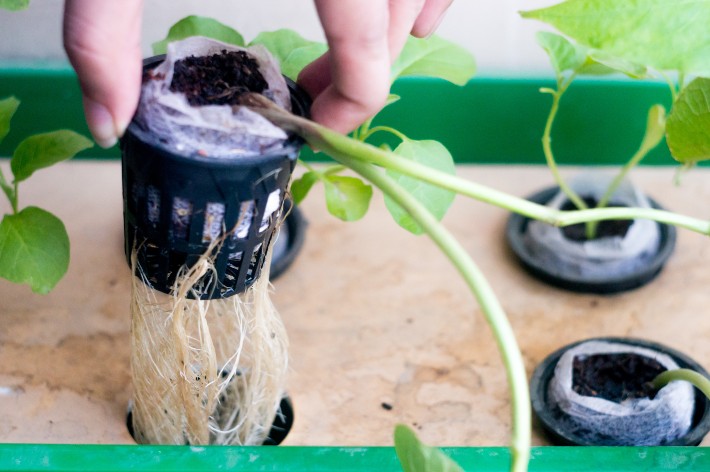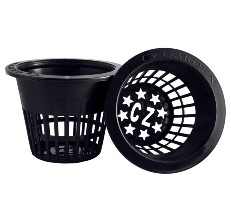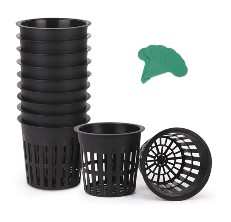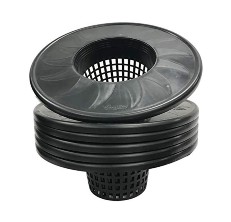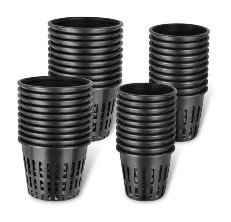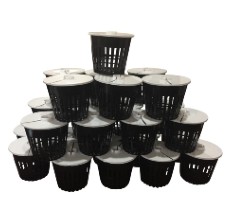- Flowers & PlantsVegetablesOur content is meticulously curated through independent research, testing, reviews, and AI-driven recommendations, all designed to present you with the finest product choices. When you make a purchase through our links, it could result in us earning a commission.
The Best Net Pots of 2024
Last updated: Apr 18, 2024
Explore our curated selection to find the right net pot for your gardening needs and watch your plants thrive like never before.
Discover the eco-friendly brilliance of net pots, an essential asset for optimal plant growth. With pre-punched slits along the sides and bottom, these pots facilitate superior drainage and air circulation, fostering sustainable growth in diverse planting mediums. Available in both round and square shapes and in various sizes tailored to different plants, net pots offer versatility and nutrient-rich potential, elevating your gardening endeavors. For the best net pot, turn to Cz Garden Supply, known for offering durable and robust net pots.
Our Top Picks For Net Pots
- Best Overall: Cz Garden Supply 3 Inch Net Pots Shop Now ➔
- Most Lightweight: xGarden Lightweight Economy Net Pot Shop Now ➔
- Most Durable: GROWNEER Garden Slotted Mesh Net Cups Shop Now ➔
- Most Easy to Clean: Viagrow V6ML-6 Net Pot Shop Now ➔
- Most Versatile: Awpeye Garden Slotted Net Pots Shop Now ➔
- Best for Apartments: Zaclon Net Pot Shop Now ➔
View all ContentsThe Best Net Pots
Best Overall
This net pot is a great option due to its superior materials and smart design features. Made with BPA-free, non-toxic, food-grade safe plastic at an affordable price, this net pot is great for the environment and your pocket! The net pot features a lower shield design, which prevents light from penetrating hydroponic reservoirs, which in turn helps reduce the root rotting disease pythium. The many narrow slits allow for both easy fastening and greater root growth in a variety of alternative soils.
The only downside to the product is that the root-trapping design on the inside makes it hard to clean which can be an inconvenience
Pros
- Lip at the top keeps sunlight out
- Very strong material
- Multiple slits allow for aeration
Cons
- Design makes it difficult to clean
- Can be incompatible with longer roots
Most Lightweight
This product is marketed as net pot cups, owing to their compact size and lightweight design. Made of plastic and fairly inexpensive, these net pots are great for those who are looking to foray into the world of hydroponic gardening but don’t want to make a big investment. The design includes meshing at the bottom, which allows for smaller substrates to be used without compromising on drainage.
However, this product only measures about 2 inches in diameter, which can be too small for most recreational gardening. Also, the top lip is too narrow to keep larger vegetables upright.
Pros
- BPA-free plastic
- Easy to control
- Good for smaller substrate
Cons
- Might be too compact for certain plants
- Top lip is too narrow
Most Durable
Available in two sizes measuring 3 inches and 4 inches respectively, this product is both durable and well-designed. In addition to the 25 mesh net cups measuring the size of your choice, this product comes with an extra 25 plant labels. These labels can be used to mark your plants for better organization.
Featuring holes at the bottom to allow for even drainage and healthier root growth as well as a wide lip along the top of the container for easier transport, the quality of these net pots lies in their design. The only downside is that the sizing is a bit misleading, as the wide lip measures up to an inch greater than advertised.
Pros
- Promotes efficient plant growth
- Comes with extra plant labels
- Sturdy and long-lasting
Cons
- The wide lip is larger than advertised
- Limited pot sizes
Most Easy to Clean
If you’re searching for a wider and deeper net pot and lid combo that fits most buckets, then the Viagrow V6ML-6 Net Pot is your best choice. The attached net pot itself measures 6” in inner diameter with a 4.5” depth, while the outer lid diameter is a cool 12 inches in diameter.
The black opaque plastic keeps lights and algae out of the net pot, and the material is sturdy and BPA-free. The size allows the net pot to fit snugly into a 5-gallon bucket, making it easy to install and maintain. However, they are one of the more expensive options on the market, and might not be worth the extra budget if you are looking for something more compact.
Pros
- Material is sturdy, making it reliable
- The net pot functions properly
- Fits well in most buckets
Cons
- Design may allow roots to grow outwards
- Can be too large for some projects
Most Versatile
Shipped with 20 pieces of each size, this product is a great option for hydroponics first-timers who are not sure which size is best for their new project. The net pots are on the more compact side, with a depth of under 3 inches regardless of size. They are great for use in mason jars due to their narrow design.
However, it is important to note that this product is definitely not heavy duty. Owing to their size, these net pots are quite flimsy and can be difficult to control. Also, the holes are not large enough to allow roots through, which can make handling fully grown plants very delicate.
Pros
- Lightweight and easy to control
- Delivered in two sizes
- Promotes even drainage
Cons
- Material may not be durable
- Lip may be too small
Best for Apartments
This net pot with mesh covers will meet your hydroponic demands. Plants and veggies may be grown more quickly and all year. Plants that are cultivated in this vented pot produce more, take up less space, and use less soil and water. If you live in an apartment and don’t have access to an outdoor gardening area, these pots are a great option.
These pots are ideal for deep water culture methods, flooding and drainage, and flowers that need a well-ventilated root region. The hydroponic pots from Kool Products are made entirely of mesh baskets. Since drip feed is employed to deliver the nutritional mix to the plants grown, these vented pots are more substantial.c
Pros
- Requires less space and conserves soil
- Best for orchids
- Perfect for deep water culture systems
Cons
- May be too small
- Debris may build up over time
The Best Net Pot Buying Guide
If you are a new entrant into the world of hydroponic gardening and are feeling a little intimidated by the novelty that is net pots, then you have come to the right place. Our take on the best net pots will be sure to clear your doubts and suspicions.
Also called net cups or mesh pots, net pots in their basic form are webbed or slotted containers with holes of varying sizes punched along all sides. Net pots are commonly used in hydroponic systems, as they allow plants to be secured properly while also making sure nutrients and water flow all the way to the root. Net pots come in many sizes and shapes, but the standard and most common design is a compact and rounded form. They are a reusable, environment-friendly, and sustainable gardening tool, making them a staple for hydroponic gardening enthusiasts. However, figuring out which net pot to invest in can be a confusing task, which is why we have prepared this buying guide to help you make your decision with ultimate confidence.
Net Pots Sizes
Net pots come in a variety of sizes, and it can be easy to get lost in the different dimensions if you’re not sure what you’re looking for. When purchasing a net pot it is essential to be aware of the sizing and whether it is appropriate for your overall system.
Net pot sizes are measured according to the diameter of the seat of the net pot. The most commonly found sizes of net pots are 2 inches, 3 inches, 3.75 inches, 5 inches, and inches”. The smaller sizes measuring 2 or 3 inches in diameter are best for smaller and more lightweight plants and vegetables as they are often not as sturdy and can tip the system over if not balanced. These sizes are perfect for use in mason jars. The mid-range size of 3.75 inches is the standard net pot size and is compatible with most medium size vegetables. 5-inch and 6-inch net pots are good for larger plants that may require more anchoring strength to allow for the root to grow and be nourished properly. For gardening enthusiasts that are looking to go all-in, net pots lids that fit into 5-gallon buckets are also available on the market. These will be best if you are looking for something that will provide your net pot with some extra depth.
For more information on selecting the correct size of net pot, this video from Simple Greens Hydroponics is a great resource:
Figuring Out Which Medium to Use in Net Pots
After size, the next question that is most daunting is which medium to use to fill your net pot. The best thing about net pots is that they are compatible with most growing mediums and are not just limited to traditional soil and fertilizer options. In fact, the soil is often not recommended for use in net pots, as it can make the overall system prone to waterlogging and root rot. Mediums such as clay pebbles, clean gravel, Rockwool, and grow sponges are all net pot-compatible. Just make sure the slots in your net pots are small enough so that the medium does not slip through them and cause potential harm to your system.
How to Decide Which Shape Is Best
Net pots come in both round and square forms, with each shape affecting the plant in different ways. Before committing to buying a net pot, make sure its shape is compatible with your project. If you are looking for a product that will fit more seeds and allow for easier removal of plants, then a square net pot would be a good option. However, square net pots may not be well-fitting in most spaces, and some adjustments may be necessary. Round net pots, on the other hand, are best for when you want to fit a larger number of plants in one area. They are often easier to install as well. The tradeoff when it comes to round net pots is that roots often become tangled which can be an annoyance.
Net Pot Lip vs Net Pot Lids: What Is the Difference?
Although they sound similar in name, net pot lips and net pot lids are two drastically different concepts each catering to a different service in the world of net pots. Before purchasing a net pot, it is essential that you are well versed in the difference between the two, and what each is useful for.
The lip of a net pot refers to the structure surrounding the top of the net pot. It is usually more textured and wider than the rest of the pot, and is especially useful in the installation and removal of net pots, as it allows for easier grip and better security of the plant. Wider lips are preferable to thinner lips and are an important feature to look out for when purchasing net pots.
Net pot lids, on the other hand, are an entirely different mechanism. When researching which net pot to buy, you might come across this additional product feature of net pot lids. Although they look confusing, they can be a valuable addition to your hydroponic system. Net pot lids are designed in such a way that they fit snugly over your net pot, often balanced on a 5-gallon bucket or some similar wide container. The function of net pot lids is to give increased protection to the plant’s roots from an excess of sunlight. In addition, net pot lids prevent water loss due to evaporation which keeps roots healthy and the plant system more secure.
People Also Asked
Can I reuse my net pot?
It is definitely okay to reuse your net pot; in fact, it is even recommended that you make it a habit to reuse your net pot, provided it is not damaged or faulty. Net pots are completely safe to be used any number of times as long as they are cleaned thoroughly. To clean your net pot, simply wash it with any trusted liquid soap and dry. For a deeper clean to make sure the net pot is properly sterilized, you can quickly boil the net pot in water between uses.
What do net pots cost?
The price of net pots varies greatly according to the material, size, and manufacturing company of the product. Net pots are often sold in packs of multiples, and pricing varies according to the number of pieces. For a pack of 12 net pots, the average price range is between $5 and $10, while a pack of 50 or more net pots can set you back between $8 and $20. Even the most expensive of net pots are still quite affordable, so be sure not to compromise on quality in your search for a good deal.
What can I use instead of net pots?
If you still aren't convinced that net pots are your best option when it comes to hydroponic gardening, there are a few other alternative products available. These include Styrofoam cups, plastic bottles, plastic cups, and grow sponges. Although these alternatives may be more attractive due to various factors, they are much more lightweight than the average net pot, which can affect your overall system. Sometimes a heavier anchoring mechanism is needed to keep hydroponic systems healthy. In that case, you can try making up the extra weight with heavier growing mediums such as pebbles or clay pellets.
Article Contributors
Read More About Garden Gate Review Team HereThe Garden Gate Review Team’s product reviews and in-depth guides are here to help you choose the best products for a beautiful and bountiful garden and backyard. The content is created by The Garden Gate Review Team. Garden Gate’s editorial staff is not involved. Garden Gate is reader-supported: When you buy through links on our site, we may earn an affiliate commission. The Garden Gate Review Team is composed of authors, editors, and gardeners. Artificial Intelligence (large language models) may have been used in the research and creation of the content.
Please reach out to aimperiapt@gmail.com with any questions regarding product testing or specific articles.
